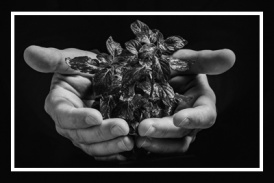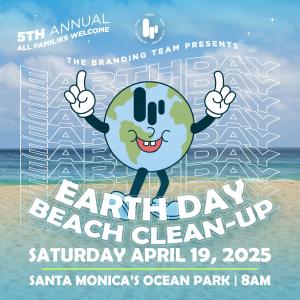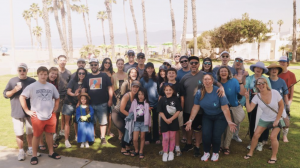Branding Los Angeles Celebrates 5 Years of Impact with Earth Day Beach Clean-Up in Santa Monica, California
This event has helped remove waste from Santa Monica beach, prevented plastic and pollutants from entering the ocean - sparking responsible living.
What started five years ago as a humble team-building initiative has transformed into a powerful annual tradition - one that unites creatives, families, students, business owners, and local residents for a shared cause: to protect and preserve the coastline that so many Angelenos call home. This year’s milestone event reflects half a decade of action, intention, and impact rooted in a genuine commitment to community and environmental stewardship.
“This event is personal to us,” says Benjamin Behrooz, Founder and CEO of Branding Los Angeles. “It’s more than a clean-up - it’s a reflection of our values and our belief that every brand, no matter its size, has a responsibility to give back to the world around it. It's our privilege to help out. Our community gives so much to us - this is just one of the many ways we strive to return that love and energy, not only to each other, but to the Earth.”
At its core, Branding Los Angeles believes that great branding begins with integrity, and there is no greater way to exemplify that than by investing in the people and places that allow us to thrive. This annual clean-up is not just a campaign - it is a hands-on demonstration of the agency’s ongoing mission to amplify purpose-driven action. Whether building brands, telling stories, or clearing beaches, the team approaches every effort with heart, creativity, and a drive for meaningful impact.
The event is open to the public, and all ages are encouraged to participate. Volunteers can look forward to:
- A morning of hands-on beach clean-up
- Opportunities for community connection and networking
- Complimentary coffee and pastries
- Cleanup tools, gloves, and supplies
- Free commemorative t-shirts
Over the past four years, this initiative has helped remove hundreds of pounds of waste from Santa Monica beach, prevented plastic and pollutants from entering the ocean, and sparked critical conversations around sustainability and responsible living.
“At the end of the day, this is about legacy,” adds Behrooznia. “It’s about showing the next generation what care looks like in action - through our work, our partnerships, and our presence. We’re not just marketing businesses - we’re shaping culture, and that comes with responsibility.”
Event Details:
Tower Crane Rental Market Size, Share, Competitive Landscape and Trend Analysis Report 2032
Donglify Launches Team Member Accounts: A Smarter Way to Share USB Dongles
Digital Manufacturing Market Analysis: Trends, Growth, and Future Outlook 2021-2030
Więcej ważnych informacji
 Jedynka Newserii
Jedynka Newserii

 Jedynka Newserii
Jedynka Newserii

Konsument

Tylko 35 proc. Celów Zrównoważonego Rozwoju ONZ możliwe do osiągnięcia przed 2030 r. Potrzebna ściślejsza współpraca międzynarodowa
Jak wynika z raportu ONZ, choć w ciągu ostatniej dekady dzięki dążeniu do realizacji przyjętych celów udało się poprawić życie milionów ludzi na całym świecie, to jednak tempo zmian pozostaje zbyt wolne, by dało się je osiągnąć do 2030 roku. Postęp hamują przede wszystkim eskalacja konfliktów, zmiana klimatu, rosnące nierówności i niewystarczające finansowanie. Jak wynika ze sprawozdania Parlamentu Europejskiego, problemem jest także brak ścisłej współpracy międzynarodowej i sceptyczne podejście niektórych państw ONZ.
Przemysł spożywczy
UNICEF: Wszystkie dzieci poniżej piątego roku życia w Gazie cierpią z powodu niedożywienia. Sytuacja jest katastrofalna

Ataki Izraela na Strefę Gazy i jej izolacja doprowadziły do całkowitego załamania podstawowych usług i ograniczenia możliwości dostaw i dystrybucji pomocy humanitarnej – wskazuje UNICEF. W efekcie setki tysięcy Palestyńczyków są w sytuacji ciągłego zagrożenia życia i cierpią z powodu niedożywienia i głodu. Ta klęska dotyczy praktycznie wszystkich dzieci poniżej piątego roku życia. Konflikty są jednym z głównych przyczyn braku bezpieczeństwa żywnościowego, głodu i niedożywienia na świecie. Szczególnie dotyczy to Afryki i Azji Zachodniej.
Prawo
Branża ciepłownictwa czeka na unijną i krajową strategię transformacji. Liczy na większe fundusze i korzystne regulacje

Komisja Europejska zapowiedziała rozpoczęcie w I kwartale 2026 roku prac nad strategią dla ciepłownictwa i chłodnictwa. Nad tym strategicznym dokumentem w zakresie ciepłownictwa pracuje także polski rząd. Branża podkreśla, że obie te strategie będą miały kluczowe znaczenie dla trwającej transformacji w ciepłownictwie, czyli przyszłości ogromnych inwestycji, które czekają sektor do 2050 roku. Jednocześnie apeluje o większe wsparcie tego procesu ze środków publicznych.
Partner serwisu
Szkolenia

Akademia Newserii
Akademia Newserii to projekt, w ramach którego najlepsi polscy dziennikarze biznesowi, giełdowi oraz lifestylowi, a także szkoleniowcy z wieloletnim doświadczeniem dzielą się swoją wiedzą nt. pracy z mediami.




![Nestlé w Polsce podsumowuje wpływ na krajową gospodarkę. Firma wygenerowała 0,6 proc. polskiego PKB [DEPESZA]](https://www.newseria.pl/files/1097841585/fabryka-nesquik_1,w_85,r_png,_small.png)






.gif)

 |
| |
| |
|